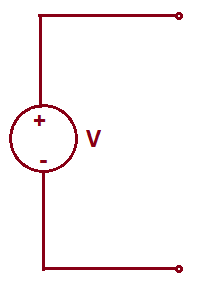Ideal Voltage Source
An ideal voltage source is defined as the two terminal device capable of providing a constant voltage across its terminals. The voltage across the terminals of an ideal voltage source remains constant and is independent of load current.
Symbol:
The symbol of an ideal voltage source is shown below.

Characteristics:
As per the definition, the voltage across the terminals of such source is always constant irrespective of the circuit resistance or output current. This means, the characteristics of this source must be as shown below.

In the above, characteristics, circuit resistance means the resistance connected across the terminals of source.
Internal Resistance:
The internal series resistance of an ideal voltage source is ZERO. Let us understand this by using the following circuit diagram.

In the above circuit diagram, R represents the resistance connected across the terminals A & B of a source having series internal resistance r. A current I is shown flowing in the circuit.
Let us now calculate the voltage across the terminals A and B i.e. VAB.
VAB = (V-Ir) …………(1)
Now, for source to be ideal, the voltage across its terminal A & B must be constant and equal to V irrespective of the value of current.
(V-Ir) = V
r = 0
Thus, the internal resistance of an ideal voltage source is always zero. However, no such source exists in the world. All the sources of voltage have some series connected internal resistance and hence its terminal voltage vary with current I as per (1). Such sources are called practical / real voltage source.
Practical Voltage Source:
A practical voltage source is one which we find around us. The terminal voltage across its terminals are not constant rather it varies with output current. Internal resistance of practical voltage source has some finite value. Though efforts are made to minimize this internal resistance. Examples of voltage sources are Batteries, Generators etc.
Symbol:
A practical voltage source is denoted as an ideal voltage source connected with a series resistance. This series resistance (r) represents the internal resistance of the source.

Characteristics:
Since the practical voltage source have finite value of internal resistance, therefore, the voltage across its terminal A&B i.e. VAB is not constant rather it depends upon the circuit current. The more the value of current, the lesser will be the magnitude of terminal voltage VAB. Similarly, if the current is less, the terminal voltage will be more. In fact, the relationship between the circuit current and terminal voltage of a practical voltage source is given as below.
VAB = (V-Ir)
For a given source, the source voltage and its internal resistance r are constant, therefore the above expression represents a straight line having slope “-r”. The characteristics of a practical voltage source is shown below.

From the above characteristic, it is clear that the terminal voltage is dependent on the output current. However, the value of internal resistance is very small and hence there is slight variation of terminal voltage with the output current. Hence, a practical voltage source approaches ideal voltage source.